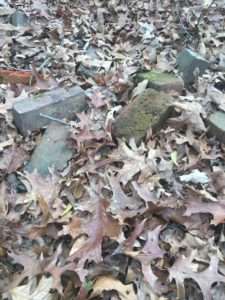In the early 1900s, there were several small schools that served what would become Sugar Hill and the surrounding communities like Buford and Suwanee.
Many of these schools were funded by the residents and, despite the limited resources, the teachers at these institutions worked hard to provide schooling to students who were from families that would otherwise have had limited access to an education. One such institution was Whiteoak School, which was located near the modern-day White Oak Elementary School and the Calaway Family Cemetery on Suwanee Dam Road in Sugar Hill. The site is protected from development by the Piedmont Land Trust. Little remains of the old school, except some bricks. Much of the information we know comes from a 1923 educational survey conducted by M.L. Duggan and his wife, Sarah Mell Duggan. The survey provides some fascinating detail into an early school system that would eventually evolve into the Gwinnett County Public School System that educates our children in modern times.
 In 1923, there were about 70 schools in Gwinnett County. Most of the buildings were one-room community supported schools, but a good number of larger schools had been built by the recently created Gwinnett County Public School System under the leadership of Superintendent H.D. Meriwether. In addition, Buford High School, under an independent school system created by a special act of the Georgia General Assembly, had a faculty of about 13 teachers. There were several small schools like Browns School, Level Creek School, Sugar Hill School, Whiteoak School and New Prospect School that were likely attended by students from the Sugar Hill area. The survey indicates a wide range of school sizes and gaps in resources that existed between the community supported schools and those funded through the independent school systems. The purpose of these types of surveys were to identify gaps and provide a baseline for improving education for students all across Georgia.
In 1923, there were about 70 schools in Gwinnett County. Most of the buildings were one-room community supported schools, but a good number of larger schools had been built by the recently created Gwinnett County Public School System under the leadership of Superintendent H.D. Meriwether. In addition, Buford High School, under an independent school system created by a special act of the Georgia General Assembly, had a faculty of about 13 teachers. There were several small schools like Browns School, Level Creek School, Sugar Hill School, Whiteoak School and New Prospect School that were likely attended by students from the Sugar Hill area. The survey indicates a wide range of school sizes and gaps in resources that existed between the community supported schools and those funded through the independent school systems. The purpose of these types of surveys were to identify gaps and provide a baseline for improving education for students all across Georgia.
M.L. Duggan and Sarah Mell Duggan visited every school during their educational survey of Gwinnett County. Their backgrounds are interesting. In addition to being husband and wife, they worked under the direction of the State Superintendent of Schools, M.M. Parks. M.L’s title was rural school agent and Sarah worked at the Extension Department for the Georgia State College for Women. Gwinnett County, and really most of Georgia, was rural in the early 1900s. No doubt, the couple would have made their way down dirt roads into areas that were infrequently visited by strangers. The Sugar Hill community, specifically along the Chattahoochee River, was considered an isolated area in the early 1900s.
When M.L. and Sarah arrived at Whiteoak School, they met Allie Benson. Allie was the teacher at the school and a descendant of one of Sugar Hill’s earliest settlers, Enoch Benson. Because of the isolation of some of these schools, the couple included nearby schools in their survey to indicate location. For Whiteoak School, they noted that Browns School was two miles to the west and New Prospect was two miles to the east. For the building itself, the survey noted: “one room, no cloak room, improperly and insufficiently lighted, good ventilation, good condition, well kept, ceiled but unpainted inside, and painted outside.” The school had just the one teacher, Allie, no programs of study and 20 students enrolled in three grade levels. On the day of M.L. and Sarah’s visit, only 10 students were present. It was very sparse inside the building, and they noticed “homemade desks, poor blackboards, no maps, no charts, no globes, no library, no reference library, and no pictures.” Amazingly, the survey included a picture of each school, so today we can visualize each building beyond mere words.
The survey completed by M.L. and Sarah is an important historical document, but they also changed history. Their survey painted a picture of Gwinnett County’s educational system and created a blueprint for improvement that is reflected in the outstanding school system we have today in our community. Many of these small Sugar Hill community schools evolved into the schools and clusters we send our children to today, like North Gwinnett High School and Lanier High School. Allie also changed history by improving the lives of her students, even with limited resources. The bricks on the site are a reminder that she laid the cornerstone for all our amazing teachers that work hard every day to educate our future community leaders.
— Brandon Hembree




